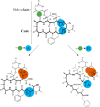Macrocyclic Gq Protein Inhibitors FR900359 and/or YM-254890-Fit for Translation?
- PMID: 33860209
- PMCID: PMC8033771
- DOI: 10.1021/acsptsci.1c00021
Macrocyclic Gq Protein Inhibitors FR900359 and/or YM-254890-Fit for Translation?
Abstract
Guanine nucleotide-binding proteins (G proteins) transduce extracellular signals received by G protein-coupled receptors (GPCRs) to intracellular signaling cascades. While GPCRs represent the largest class of drug targets, G protein inhibition has only recently been recognized as a novel strategy for treating complex diseases such as asthma, inflammation, and cancer. The structurally similar macrocyclic depsipeptides FR900359 (FR) and YM-254890 (YM) are potent selective inhibitors of the Gq subfamily of G proteins. FR and YM differ in two positions, FR being more lipophilic than YM. Both compounds are utilized as pharmacological tools to block Gq proteins in vitro and in vivo. However, no detailed characterization of FR and YM has been performed, which is a prerequisite for the compounds' translation into clinical application. Here, we performed a thorough study of both compounds' physicochemical, pharmacokinetic, and pharmacological properties. Chemical stability was high across a large range of pH values, with FR being somewhat more stable than YM. Oral bioavailability and brain penetration of both depsipeptides were low. FR showed lower plasma protein binding and was metabolized significantly faster than YM by human and mouse liver microsomes. FR accumulated in lung after chronic intratracheal or intraperitoneal application, while YM was more distributed to other organs. Most strikingly, the previously observed longer residence time of FR resulted in a significantly prolonged pharmacologic effect as compared to YM in a methacholine-induced bronchoconstriction mouse model. These results prove that changes within a molecule which seem marginal compared to its structural complexity can lead to crucial pharmacological differences.
© 2021 The Authors. Published by American Chemical Society.
Conflict of interest statement
The authors declare no competing financial interest.
Figures







Similar articles
-
Unraveling binding mechanism and kinetics of macrocyclic Gαq protein inhibitors.Pharmacol Res. 2021 Nov;173:105880. doi: 10.1016/j.phrs.2021.105880. Epub 2021 Sep 17. Pharmacol Res. 2021. PMID: 34506902
-
Rational design of a heterotrimeric G protein α subunit with artificial inhibitor sensitivity.J Biol Chem. 2019 Apr 12;294(15):5747-5758. doi: 10.1074/jbc.RA118.007250. Epub 2019 Feb 11. J Biol Chem. 2019. PMID: 30745359 Free PMC article.
-
Delineation of molecular determinants for FR900359 inhibition of Gq/11 unlocks inhibition of Gαs.J Biol Chem. 2020 Oct 2;295(40):13850-13861. doi: 10.1074/jbc.RA120.013002. Epub 2020 Aug 4. J Biol Chem. 2020. PMID: 32753482 Free PMC article.
-
Recommended Tool Compounds: Application of YM-254890 and FR900359 to Interrogate Gαq/11-Mediated Signaling Pathways.ACS Pharmacol Transl Sci. 2023 Nov 10;6(12):1790-1800. doi: 10.1021/acsptsci.3c00214. eCollection 2023 Dec 8. ACS Pharmacol Transl Sci. 2023. PMID: 38093837 Free PMC article. Review.
-
Recent achievements in developing selective Gq inhibitors.Med Res Rev. 2020 Jan;40(1):135-157. doi: 10.1002/med.21598. Epub 2019 Jun 19. Med Res Rev. 2020. PMID: 31218731 Review.
Cited by
-
Structure-affinity and structure-residence time relationships of macrocyclic Gαq protein inhibitors.iScience. 2023 Mar 23;26(4):106492. doi: 10.1016/j.isci.2023.106492. eCollection 2023 Apr 21. iScience. 2023. PMID: 37091255 Free PMC article.
-
QSP modeling of a transiently inactivating antibody-drug conjugate highlights benefit of short antibody half life.J Pharmacokinet Pharmacodyn. 2024 Dec 17;52(1):7. doi: 10.1007/s10928-024-09956-1. J Pharmacokinet Pharmacodyn. 2024. PMID: 39690276 Free PMC article.
-
Plant peptides - redefining an area of ribosomally synthesized and post-translationally modified peptides.Nat Prod Rep. 2024 Jul 17;41(7):1020-1059. doi: 10.1039/d3np00042g. Nat Prod Rep. 2024. PMID: 38411572 Free PMC article. Review.
-
Structural response of G protein binding to the cyclodepsipeptide inhibitor FR900359 probed by NMR spectroscopy.Chem Sci. 2024 Jul 4;15(32):12939-12956. doi: 10.1039/d4sc01950d. eCollection 2024 Aug 14. Chem Sci. 2024. PMID: 39148790 Free PMC article.
-
Imaging of Gαq Proteins in Mouse and Human Organs and Tissues.Pharmaceutics. 2022 Dec 24;15(1):57. doi: 10.3390/pharmaceutics15010057. Pharmaceutics. 2022. PMID: 36678686 Free PMC article.
References
-
- Fujioka M.; Koda S.; Morimoto Y.; Biemann K. (1988) Structure of FR900359, a cyclic depsipeptide from Ardisia crenata Sims. J. Org. Chem. 53, 2820–2825. 10.1021/jo00247a030. - DOI
-
- Carlier A.; Fehr L.; Pinto-Carbó M.; Schäberle T.; Reher R.; Dessein S.; König G.; Eberl L. (2016) The genome analysis of Candidatus Burkholderia crenata reveals that secondary metabolism may be a key function of the Ardisia crenata leaf nodule symbiosis. Environ. Microbiol. 18, 2507–2522. 10.1111/1462-2920.13184. - DOI - PubMed
-
- Taniguchi M.; Nagai K.; Arao N.; Kawasaki T.; Saito T.; Moritani Y.; Takasaki J.; Hayashi K.; Fujita S.; Suzuki K.-i.; Tsukamoto S.-i. (2003) YM-254890, a novel platelet aggregation inhibitor produced by Chromobacterium sp. QS3666. J. Antibiot. 56, 358–363. 10.7164/antibiotics.56.358. - DOI - PubMed
-
- Schrage R.; Schmitz A.-L.; Gaffal E.; Annala S.; Kehraus S.; Wenzel D.; Büllesbach K. M.; Bald T.; Inoue A.; Shinjo Y.; Galandrin S.; Shridhar N.; Hesse M.; Grundmann M.; Merten N.; Charpentier T. H.; Martz M.; Butcher A. J.; Slodczyk T.; Armando S.; Effern M.; Namkung Y.; Jenkins L.; Horn V.; Stößel A.; Dargatz H.; Tietze D.; Imhof D.; Galés C.; Drewke C.; Müller C. E.; Hölzel M.; Milligan G.; Tobin A. B.; Gomeza J.; Dohlman H. G.; Sondek J.; Harden T. K.; Bouvier M.; Laporte S. A.; Aoki J.; Fleischmann B. K.; Mohr K.; König G. M.; Tüting T.; Kostenis E. (2015) The experimental power of FR900359 to study Gq-regulated biological processes. Nat. Commun. 6, 10156.10.1038/ncomms10156. - DOI - PMC - PubMed
LinkOut - more resources
Full Text Sources
Other Literature Sources
